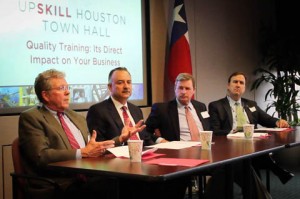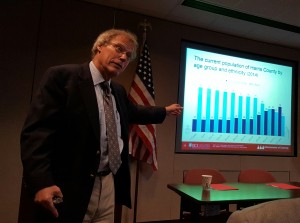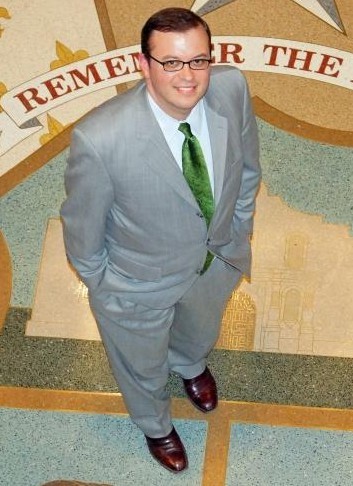
A town hall-style discussion about workforce was recently held in the offices of the Greater Houston Partnership.
Business leaders in Houston seem well-positioned to set the tone for how the rest of the nation addresses workforce challenges, experts agree. During a town hall-style event hosted by the Greater Houston Partnership, health care leaders, construction executives and others discussed ways the private sector is taking the lead to ensure that a quality workforce can be cultivated and sustained for decades to come.
“Industry is truly leading the initiative,” said Peter Beard, Senior Vice President of Regional Workforce Development at the GHP. He opened a panel discussion by giving specific praise to the construction and petrochemical sectors and said there is a belief that “we share, fundamentally, a workforce.” That’s why addressing the needs of employers and employees will “take a collective effort,” Beard said.
The town hall focused on quality training through the Construction Career Collaborative, or C3, and putting people to work via the Partnership’s UpSkill initiative, which is designed to match employers across seven sectors with individuals who have more than a high school diploma but less than a four-year degree. Those are known as “middle skill” careers.
Industry estimates show 40 percent of the current workforce will retire in the next decade, meaning 185,000 new craft professionals will be needed in the United States each year. More than 7,000 new construction job openings will be posted per year in Houston alone. Meantime, there’s been a 15 percent decline in new workers in formal training programs over the last decade.
While many see it as a big upfront cost, craft training consistently results in savings for businesses that reap $1.30 up to $3.00 in benefits for each dollar invested and $2,400 average cost savings.
Texas Children’s Hospital and MD Anderson Cancer Center have adopted C3 principles along with the Memorial Hermann Healthcare System, the Museum of Fine Arts-Houston, the Catholic Archdiocese of Galveston–Houston, Hines, Jones Lange LaSalle, and the Greater Houston Partnership.
Peter Dawson, Senior Vice President of Facilities Services at Texas Children’s Hospital, said the ability of many construction firms to do quality work has faded for a variety of reasons. For “serial builders” like health care providers, a lack of quality construction drives their costs much higher. “Now we’re waking up to that fact,” Dawson said. “It costs more to have a cheap building than it does to have a good building,” he said, referring to the costs associated with maintenance over the entire life of a facility.
Chief Facilities Officer at M.D. Anderson, Spencer Moore, underscored Dawson’s point by saying the costs for a commercial building are comprised of roughly 20 percent for construction and typically 80 percent for maintenance. Moore said labor disputes have been quelled thanks to adopting C3 principles. For example, when ironworkers were protesting at a project a few years ago, the situation was diffused thanks to a proactive approach to craft training, hourly wages, and safety training.
The construction industry is “at a crossroads,” said Kevin Camarata, the CEO of Camarata Masonry who is also a C3 board member. Camarata said companies are increasingly competing for an established workforce, but challenges include an image problem driven mainly by low wages. Wages have started to improve though, he said. “Now that the wages are reasonable, I think it’s attractive to a different class of young people,” Camarata said.
Camarata said recruitment will remain difficult until the problem of worker misclassification is addressed in a broad-based way. It is an issue that Construction Citizen has covered extensively over the years. Misclassification happens when a business pretends its workers are independent subcontractors when, by law, they meet the IRS definition of employees. Unethical companies engage in the practice to avoid payroll taxes and benefits, giving them a huge competitive advantage. One of C3’s requirements, Camarata said, is that companies must properly classify their workers.
“Craft training is a mindset,” said Chuck Gremillion, Executive Director of C3. He said many companies “don’t even know where to start,” so the non-profit is working to create a template that can be adapted for different trades. It’s a long-term commitment, Gremillion said: “It won’t happen overnight.”
Mike Holland, Chief Operating Officer of Marek Construction, said what’s needed is “a fundamentally sound worker who can scale up.” The entire process starts with the education of the craft professional, but “it doesn’t end after two years. It doesn’t end after four years,” he said. “It doesn’t sustain if it has no beginning,” Holland said, referring to the urgent need for more owners to demand proper training.
“If you train a man and you give him the proper tools and you don’t make him work 80 hours a week, he’ll last a long time,” said Stan Marek, CEO of Marek. People work in good health for his family’s company for decades thanks to fair treatment and proper training, Marek said.
Construction Career Collaborative Chairman Jim Stevenson said the licensed crafts seem to be doing better than unlicensed ones. “It’s fundamental that we attract and then train people in our industry and then keep them,” Stevenson said. He said it is very telling that virtually every major construction firm has a safety director but does not necessarily have their own craft training director. They should strive to have both, he said. That lack of training at many firms has driven down the productivity of workers – translating to stagnant wages – while construction costs are exponentially higher than they were decades ago.
Prior to the panel discussion, Rice University Sociologist Dr. Stephen Klineberg gave a short but enlightening talk about the Houston region’s demographics as well as the challenges and opportunities associated with the area’s incredible diversity.
Southeast Texas is now the most ethnically diverse region in the United States, Klineberg noted. “We are a free people and we come from everywhere,” he said. “No city has benefited more from immigration than Houston, Texas.” The economic vitality of the region, particularly its ability to be the last into the recent recession and the first out, is “purely” because of its incredible diversity.
Klineberg told business leaders that the various ways they participate in addressing economic and social issues can be a blueprint for the nation. “By 2050, all of America is going to look the way Houston looks now,” Kleinberg said. “This is where people will look to see what can America be.”
This article originally appeared on Construction Citizen.


